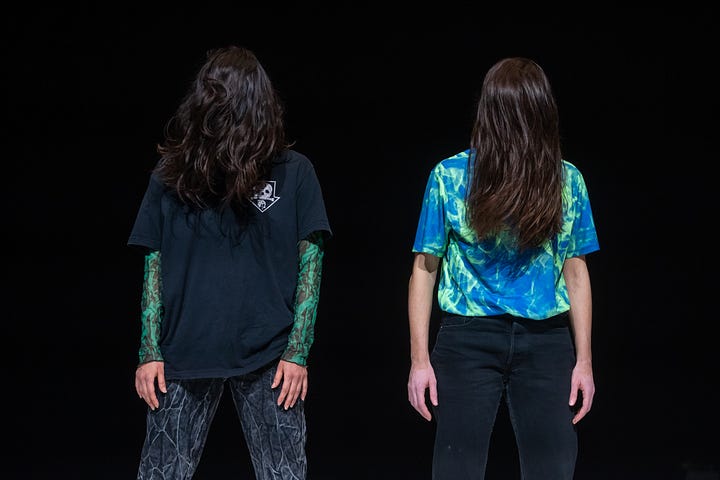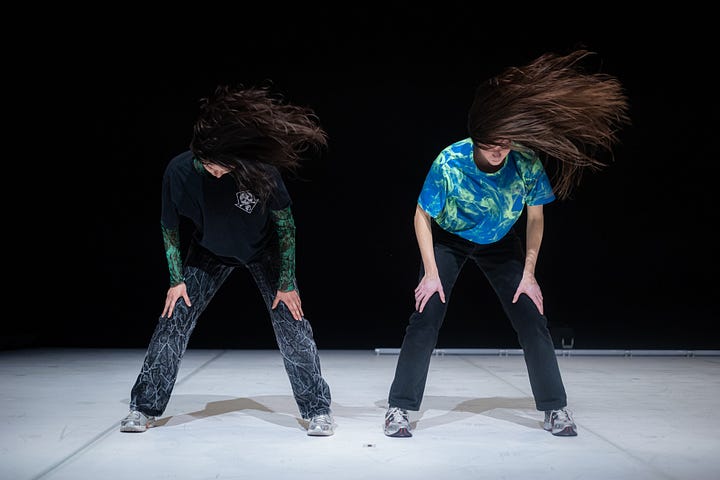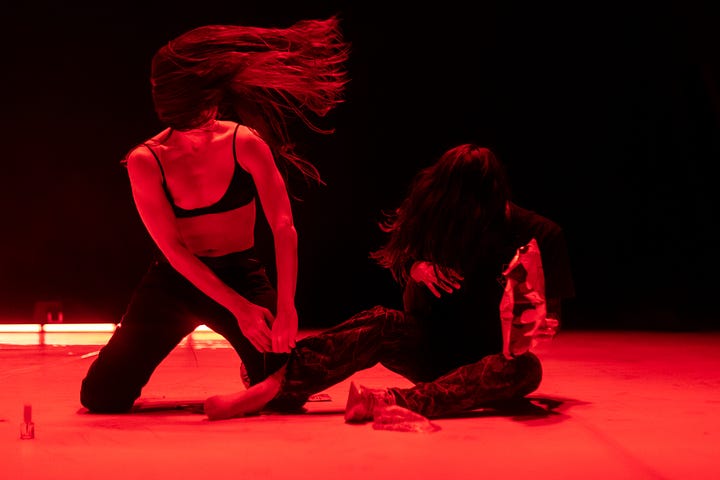16.01.2024
What’s the hairy fuss? Productive confusion and bodily exuberance in “Bang Bang Bodies”
Dance
Unlike other body parts, hair has a life of its own; it grows rather fast, we could even modify it by changing hair-cut or even colour. There is, though it is less frequently theorized, a discursive repositioning of the self via hair symbolism; it is a malleable raw material, an element in which identity can be inscribed onto the body, a means to achieve the production/consumption of an aesthetically pleasing self. Rock or metal bands and their fans are no exception to all the above. For them, hair has been perceived persistently as a cultural signifier against norms and a performance enhancer in various gigs. For these music subcults, headbanging has evolved into the rhythmic, monotonous and yet violent shaking of the head, practiced mostly by men during live performances. Long hair, in this case, plays a leading role; it reinforces aspects of masculinity that abide by the cultural values of the subcult, it becomes sort of an ’emblem’ by which members of a group could identify others, ascribe thus to it cultural significance.
Xenia Koghilaki in her dancing duo “Bang Bang Bodies”¹ proposes a re-examination of the above cultural significations attached to headbanging, but also experiments ―according to my reading of her piece― with hair as body-prosthesis, a playful way to regenerate the dancing body towards new modalities of sensing and moving. The prosthetic suggests “a vocabulary of more-than,”² as Erin Manning implies, thus introduces the “prosthetically enhanced” body as an instance of interrelation: Moving the hair could also mean learning how to move with the hair. In her piece, thus, hair makes the difference. If it is not caught in a strict ballet bun or stylised for the purpose of referencing some yester-era, hair is mostly an aesthetic element which is there but not necessarily to be looked at carefully. It is rather considered a part of the body that interferes with movement, something to be controlled so we could clearly see the face of the performer, her expressions, her gaze reaching out to the audience. Despite this flat way of sensing hair movement in a dance performance, hair flips, sways, seduces, it is even believed to have magical powers. But why all this hairy fuss?

In “Bang Bang Bodies” Koghilaki references speed metal only for some seconds in the opening of the show; upon the performers’ entrance strobe lights and thrash music prevails. Cut. What follows has nothing to do with rock-metal mayhem or deafening music. The two performers activate the space differently; first they remain floating in a state of dormancy, as if just awaken. Their movements are almost imperceptible, their heads slightly ticking, their faces covered with a peplum of hair. Hair functions like a curtain, a pendulum moving from side to side, a hypnotising mechanism which helps re-articulate body-oriented movement. Moving hair also makes more difficult the orientation of the performers, re-prioritises body parts and ultimately shifts proprioception. It is precisely in this perception shift, that hair becomes an “object-event” in order to contemplate how a movement evolves, to capture the miniscule pre-acceleration moment in which a tendency develops into clear and extensive displacement.
Moving hair becomes a mode of movement mapping; waving, flipping, spinning the head but also holding the right body position so as to sustain the movement. If I had to return to my notes taken during the show, I would recognise a score in which hair binds and/or disrupts the flow of actions unfolding and underlines how our perception is activated. Whether hair interferes with choreography or becomes an element of it, it could help us perceive what Manning implies when saying “what we perceive first is not an object but how it worlds.”³ Hence, to think of hair not an “object as such, but how it merges with experience: the object is its experiential function”⁴ by proposing a wealth of potential and multiple readings of that potentiality. Enter, strobe, headbang, hair moving, cut, silent break, slow motion, hair swaying, knees bent, bodies forward, head spinning, fast, slow, hair hanging, circle, heart-beat, weight shifting, hands reaching, holding, side stepping, heads close, hair touching, music is great, separating, on fours, hair touching ground, Christina takes something out, tobacco?, she is rolling a cigarette, Xenia takes her t-shirt off, high energy banging, together and so on.

The “experiential function” of hair-as-object or as-prosthesis, however paradoxical, is only suggested here as a tool to understand movement as a field of relations. Relations that might suggest, as we mentioned above, a re-conceptualisation of the moving body, its contours and how it is placed in the world. Although the bare stage is a far cry from any real-world environment, de-emphasizing self-oriented movement towards more abstract notions of moving-with, remains crucial if we want to adapt to more versatile readings of choreography and dance. If an expanded perception of movement and dance phenomena is to be claimed, I believe it should be done also through notions, for example, as the Latourian imbroglio, a confusion in which “it’s never clear who and what is acting.”⁵ This sort of confusion does not mean rejecting human being or their place in the world. Rather, as in the case of “Bang Bang Bodies” and the proposed reading of the performance, confusion could also signify “human enhancement” or even more pliant understandings of human identity and humanness expressed through movement.

Xenia Koghilaki (SNF ARTWORKS Dance Fellow 2022) develops both collaborative and solo works at the intersection of dance, choreography, and performance. Berlin-based since 2019, she holds an MA in Solo/Dance/Authorship (MA SODA) from the Inter-University Center for Dance, Berlin University of the Arts (HZT/UDK). She is a graduate of the Department of Architecture, University of Patras and of the National School of Dance in Athens. Xenia puts the body in the center of her interest, exploring concepts of collectivity and belonging, in relation to dance and choreography, while her artistic interest focuses on challenging the triptych: power - knowledge - body.
Anastasio Koukoutas is working in the field of dance theory, dramaturgy and writing. He studied (BA) Communication and Marketing at the Athens University of Economics, (MA) Performing Arts Administration at Accademia Teatro alla Scala (in collaboration with Bocconi University), Ethnomusicology at the National and Kapodistrian University of Athens (within the e-learning course Greek Music Culture and Education). He has worked, in the publishing field, as a contributor and editor, for art institutions and organizations, such as: Athens & Epidaurus Festival, Stegi Onassis, Dimitria Thessaloniki Festival, Megaron - The Athens Concert Hall et.al. He has worked as a dramaturg in theatre and dance performances (Athens Festival, Stegi Onassis, Experimental Stage of National Theatre in Greece, Arc for Dance Festival, Porta Theatre - Athens et.al.). He writes frequently about dance for the websites springbackmagazine.com, artivist.gr, und-athens.com, and teaches Dance History at the dance college ΑΚΤΙΝΑ. Last but not least, he has worked as a performer for Denis Savary (Lagune –National Museum of Contemporary Art, Athens - 2016), Virgilio Sieni (Biennale Danza / La Biennale di Venezia - 2016), Pierre Bal Blanc (documenta14–2017), Dora Garcia (Megaron, The Athens Concert Hall - 2018) et. al.
¹The work was first presented in June 2021 within the framework of the MA SODA program at the Inter-University Center for Dance Berlin (HZT) and had officially premiered in TANZTAGE BERLIN 2023 festival. I saw it during the Onassis Dance Days (Athens) with Xenia Koghilaki and, understudy, Christina Karagianni.
²Erin Manning, Relationscapes - Movement, Art, Philosophy, The MIT Press, Cambridge/Massachusetts, 2009
³ ibid, p.68
⁴ ibid, p.73
⁵ Bruno Latour, Reassembling the Social - An Introduction to Actor-Network-Theory, Cambridge University Press, 2007, p. 46



